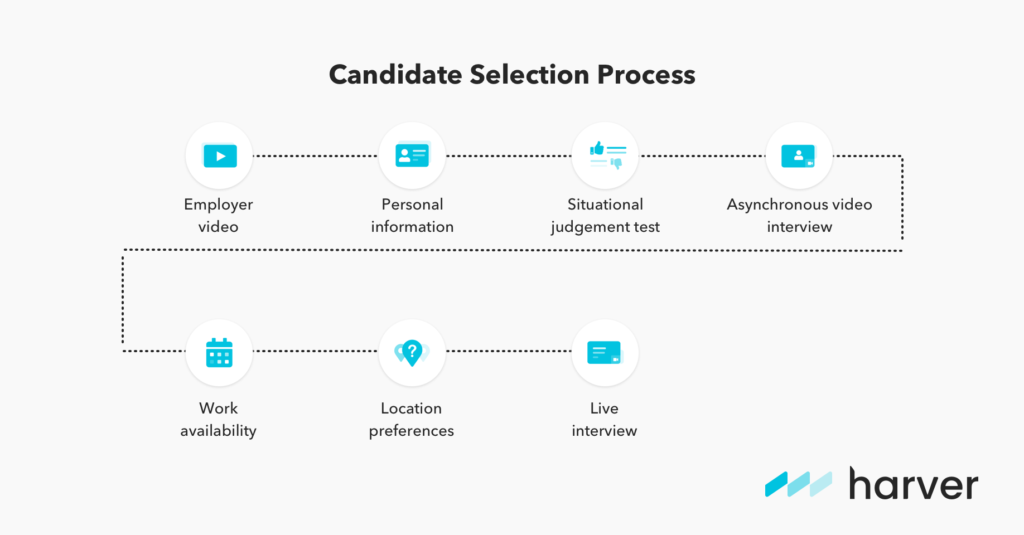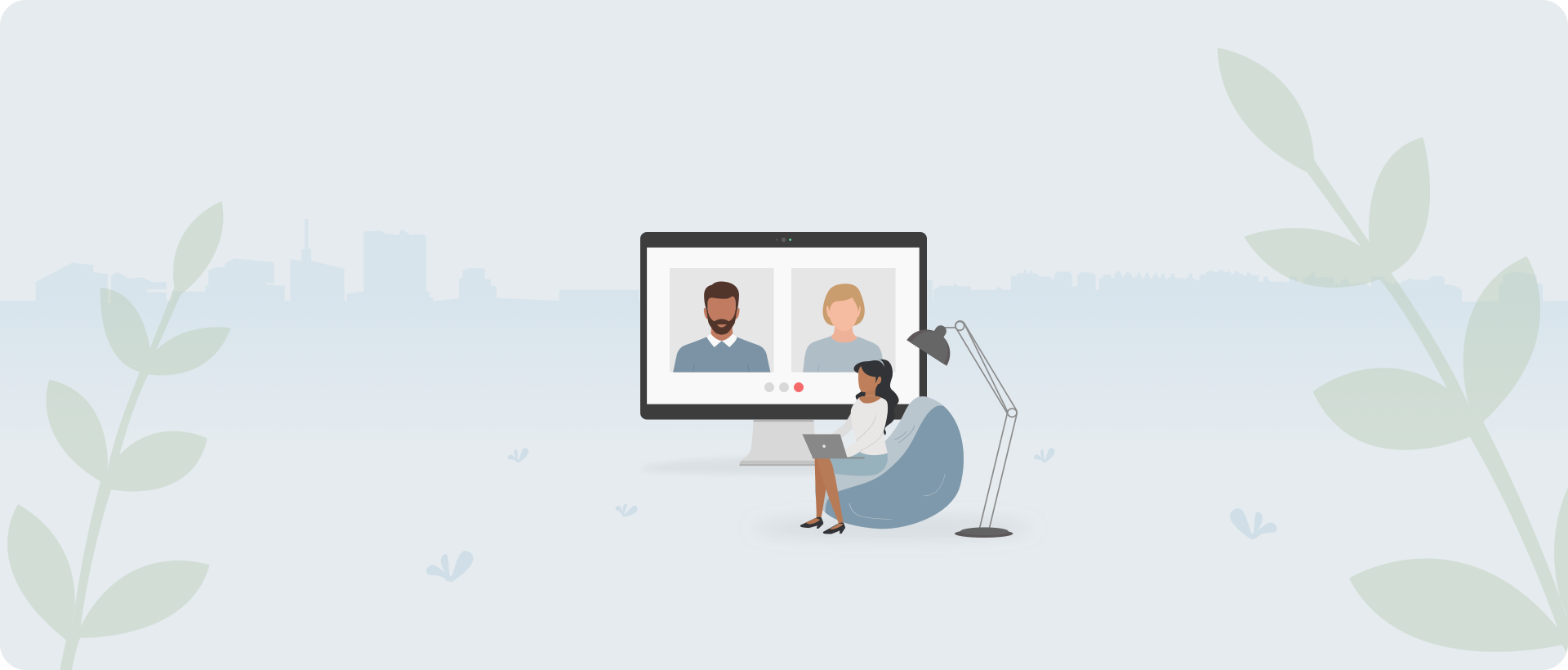Digital interviewing in volume hiring is much more complex than in regular recruiting, not only because of the sheer volume of applicants that you have to evaluate, but also because you need to make sure recruiters are available to attend the interviews.
This is especially important when hiring in tight markets where competition for talent is fierce, as it helps shorten the length of the selection process, and offer candidates job security faster than competitors.
Depending on the size of your talent team, you might want to opt for live video interviews or for one-way interviews that consist of a set of predefined questions that candidates have to answer. Each of these options has its advantages and drawbacks, and comes with specific implementation guidelines or best practices.
We’ll walk you through the process of implementing digital interviews in volume hiring, to give you a better understanding of how these interviews work and the main aspects you should pay attention to. But first, do you even need video interviews in your hiring process?
What’s in?
Deciding if you need digital interviews in your hiring process
Video interviewing makes a great addition to your hiring tool kit, adding a qualitative element to your pre-employment assessments. However, it isn’t always a necessary step to include in your recruitment process.
So what can you do to ensure that if you’re using digital interviews when volume hiring, it works for you? Well, we suggest you start with the big picture: decide if and/or when you’ll use digital interviews, what tool you’ll use, at what stage of the recruitment process you’ll implement them, and how the digital interview will influence the results and the hiring decision.
For example, if you use one-way (asynchronous) interviews, you need to make sure the questions asked are relevant. You also need a way to persuade candidates to actually record answers. Plus, the digital interview tool you’re using should integrate with your HR/recruitment tech stack to avoid data getting lost or recruiters wasting time by switching between systems.
Here are some general guidelines to help you make a more informed decision.
When you might need to use digital interviews
When schedules don’t align. If you’re struggling to schedule in-person interviews – you might have time differences, health issues, even work schedules to contend with – opting to use synchronous video interviews allows both parties to schedule an interview that works with their schedule.
If using asynchronous interviews, it doesn’t matter if schedules don’t align because candidates record their interview responses at a time and location that works for them, and hiring teams evaluate the candidate when it suits them. Candidates and interviewers still ‘speak’ with one another, just not at the same time.

When candidates are remote. If you’re recruiting international candidates to fill your roles, with synchronous or asynchronous digital interviews, distance is no longer an issue.
When you need to hire fast. Video interviewing allows you to get to know candidates faster than a resume alone. If you need to hire candidates who speak a foreign language, for example, with an asynchronous digital interview, you can assess their language skills quickly and easily by asking them a question in the target language. Or if you need to fill sales roles, a video interview reveals a lot about a candidate’s communication and presentation skills simply by their presence on screen.
When you want a great candidate experience. Interviews are stressful, there’s no denying it. To help improve your candidate experience, offering video interviews alleviates some of the pressure. With asynchronous video interviewing, for example, candidates get the chance to re-record their answer if they muck it up, presenting themselves to the best of their ability.
When you have multiple interviews. Remove bias from the interview process by using structured asynchronous interviews that ask all candidates the same questions, in the same order. Candidates get the opportunity to prepare their answers beforehand, and recruiters can evaluate candidates’ answers objectively, because the only information they have to go on is what the candidate chooses to reveal.
When you want to get to know candidates better. Sometimes you might need candidates with intangible skills that can’t be described in words or through numbers, i.e. you want to see someone’s body language, or how warm and welcoming someone naturally is. You can’t assess this particular characteristic easily, it’s something that people either possess or don’t. Both asynchronous and synchronous digital interviews work well for this.
When it’s better to skip digital interviews
- When you don’t have the right software. Some video software doesn’t allow candidates to re-record their answers, or see the questions beforehand for an asynchronous interview. This can make the whole experience even more stressful for applicants than interviewing with a live person, because there is no way for the candidate to clarify the question, or have it explained in a way that they understand it.
- When candidates aren’t comfortable recording themselves. Not everyone is comfortable being in front of a camera and recording themselves. If you don’t want to risk putting off applicants, consider using alternative screening methods instead, or allowing candidates to skip the recorded interviews.
- When you aren’t making data-driven hiring decisions. If you’re still relying on intuition or a gut feeling to make a hiring decision, asynchronous video interviews can actually introduce hiring bias into the equation, because you aren’t able to have a synchronous conversation with candidates. What the recruiter sees and hears, is all they have to base their decision on.
- When candidates can’t find out more about your organization. Synchronous interviews are a great way to not only meet a candidate, but they provide an excellent opportunity to sell the company too. Asynchronous interviews don’t allow this – candidates can’t ask questions of the hiring manager. However, you can overcome this issue by incorporating realistic job previews in the application process.
With this in mind, let’s take a closer look at the two main types of digital interviews mentioned above.
Like what you see?
Don’t miss out. Subscribe to our quarterly digest to get the latest TA and TM resources delivered right to your inbox.
What are the different types of digital interviews?
As we’ve alluded to above, there are two main types of digital interviews:
- Live video interviews, also referred to as synchronous digital interviews
- Virtual one-way interviews, also referred to as on-demand or asynchronous interviews
1. Asynchronous (on-demand, one-way) interviews
Asynchronous interviews can be used to enhance your pre-assessment stage. They give you the opportunity to get a more rounded picture of a candidate before deciding whether to take to them forward or not. They’re beneficial for applicants too because they get the opportunity to present themselves more fully than their resume allows.
How do asynchronous interviews work?
Your hiring managers pre-record questions that every applicant answers. Candidates, when they reach this stage of the application, record their answers and your hiring team watches their replies back at a later time.
Some might argue that requiring candidates to commit to you so early in the application process might cause higher drop off rates, but the counter to that is – if candidates aren’t willing to put the effort in now, will they last the distance anyway?
Why use asynchronous interviews?
Asynchronous interviews save you time, money, and effort in the long run. They negate the need to hold in-person interviews early on in the hiring process, or go through the rigmarole of a time consuming phone interview. When utilised properly, asynchronous interviews improve both the recruiter and the candidate interview experience.
For example, Harver’s virtual (on-demand) interview solution enables clients to customize their interviews by adding questions that can be used to complement other pre-employment assessments used.

The candidate goes through the application flow, sees the questions and video records their answer to each one. Once complete, they progress automatically onto the next assessment.
Once the candidate’s video answers are submitted, recruiters can watch the videos in the platform’s backend and can rate their answers with 1-5 stars, depending on their response.
Candidates can skip the video questions if they’re having technical difficulties, for example if their phones aren’t equipped with cameras, or their internet connection is slow.
We believe asynchronous interviewing is the perfect addition to your recruitment flow particularly if you don’t have enough recruiters to carry out live interviews, or you don’t want to waste their time with live interviews so early in the application process.
You can learn more about our asynchronous interview module below.
2. Synchronous (live, two-way) interviews
A two way (synchronous) interview is the most common type of digital interview. This live interview is where candidates and interviewers log into the video call at the same time and have a two way interview, regardless of where they’re located or what timezone they’re in.
How do synchronous interviews work?
Synchronous digital interviews require you to have dedicated video interview software in place, that is, software with functionalities built-in to streamline the recruitment process when hiring at scale. While you can use regular tools such as Zoom, sooner or later you’ll run into a series of limitations that will make you search for a tool designed with the specific challenges of volume hiring in mind.
You need software with functionalities that help drive efficiencies for your recruiters such as interview scheduling capabilities, a whiteboard for collaboration, integration with your existing Applicant Tracking System (ATS), interview recording as well as allowing you to embed evaluation forms.
Why use synchronous interviews?
Synchronous digital interviews are particularly useful when you have a large number of candidates to interview to make a final hiring decision, quickly. You don’t have to deal with the logistics of booking meeting rooms, or finding a time or location that suits both parties.
They’re the perfect solution when you’re looking to reduce your time to hire, when you need to eliminate the risk of bias, when you need to decrease hiring costs. Synchronous interviews are best used at the end of the application process, after you’ve assessed a candidate’s skills and characteristics. They’re your opportunity to ‘meet’ the candidate.
Harver’s virtual live interview solution
Harver’s synchronous interview module is similar to Zoom and Teams in terms of functionality. Recruiters simply join the interview via the link on the candidate’s detail page and clicks to join, just as you would with a Zoom link.
Candidates login for their interview and go through a short preparation process that helps them set up the webcam and microphone and give access permission if required. Once the setup is done, they can join the live interview with the recruiter.
During the live video interview, the recruiter has access to the candidate’s assessment scores and results, to their resume and application information, as well as their detailed profile. Once the live video interview is done, the recording appears in the candidate’s profile page, offering the talent team a detailed overview of the candidate’s profile.

For more information about synchronous interviews or to see our digital interview solution in action, you can schedule a demo below.
If you’d like to see how Haver can transform your hiring process,
book a demo here!
Technical considerations when implementing digital interviewing
When implementing a digital interviewing module into your application process, either synchronous or asynchronous, there are certain technical considerations you should be aware of:
- When and where will candidates schedule the interview or record their answer? At which point in the application flow do you need to implement the module? Only at the end? Only for candidates who meet certain criteria? Or for everyone? Will all candidates be allowed to schedule interviews? If not, what criteria will you use?
- How will this look in the backend for recruiters? Do you want them to have to login into a separate digital interview platform just for interviews, or do you want this synchronized with your ATS info? Or should the video interviewing feature be part of an end-to-end digital hiring solution for volume recruitment?
- Where will the candidates’ recorded answers be stored? For example, Harver allows recruiters to see the interviews and the recordings in the candidate detail page, for a full picture.
- How many questions will you record? Who will record them? Will you customize these questions for the different roles?
Digital interview best practices for hiring managers
To get the most out of your synchronous digital interviews, we’ve compiled a list of digital interview tips for recruiters and hiring managers.
Before the interview
- Prepare by reviewing the candidate’s profile and application materials and getting familiar with the role. Review the job descriptions or profiles to refresh your memory, and be prepared to talk about the role and company, to answer candidates’ questions.
- If using assessments in your selection process, make sure you review the candidate’s skills and characteristics, as well as the answers to questions evaluating their culture fit.
- Get familiar with the interview tools, review the categories of questions you’ll ask and the questions, and be ready to explain how the selection process works and what the next steps are, if any. Set sufficient time aside for the interview, and double-check your internet connection, camera and microphone.
During the interview
- Begin the interview by setting the stage and helping the candidate feel comfortable sharing information. Set expectations and build rapport from the beginning, before jumping into the interview questions.
- Mix the types of questions used by incorporating work history, competency and follow up questions. Make sure to take notes to help you with the final hiring decisions.
- Close the interview by letting the candidate know what the next steps are, as well as the timeline for when they can expect a decision from you. Don’t forget to thank them for their time.
Next steps
Digital interviews, both synchronous and asynchronous, are a great addition to your recruitment process. While there is a plethora of video conferencing software available to help organizations carry out virtual interviews, not all of them will have the functionality you require to do volume hiring fast and efficiently.
Take the time to review the bigger picture before you choose your digital interview software provider – you want one that integrates with your existing tech stack, that streamlines your interview process, that will allow you to interview candidates at scale, all the while delivering an outstanding experience, and enabling you to make a data-driven hiring decision.
Harver is built for volume hiring. To find out more about how Harver can support you with digital interviews, you can book a demo below.
Ready to transform your hiring process?



